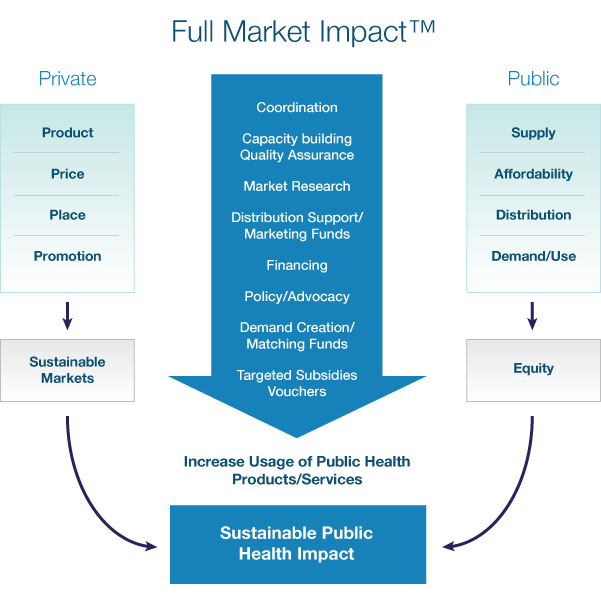
Full Market Impact™
AED's Full Market Impact™ (FMI™) model provides the framework for our public-private partnerships in programs. The FMI™ approach engages partners from the private sector, non-governmental organizations, and the public sector in comprehensive and synergistic efforts that aim to increase the practice of healthy behaviors, and generate and fulfill demand for an affordable and accessible range of "public health" products and services.
FMI™ addresses the four P's of marketing, (product/supply, price/affordability, place/distribution, and promotion/demand and appropriate use) and has three expected outcomes—equity, commercial viability, and sustainable public health impact.
The following summarizes the strategies for addressing FMI™ components and outcomes:
The Four P's of Marketing
Product/Supply
- Increase supply of health commodities and services by supporting partners in the private, public, and NGO sectors to expand marketing of existing and new products and services that meet the needs and desires of target groups.
- Encourage the commercial health sector in the developing world to go beyond its traditional (higher-income, higher-margin, and more profitable) markets, and reach down to the "base of the pyramid."
- Facilitate market segmentation—where the private, public, and NGO sectors all play a critical role in serving the total market—taking advantage of each sector's comparative strength.
Price/Affordability
- Increase use of public health products and services among at-risk and vulnerable groups by ensuring access to subsidized products and services while promoting affordable full-priced products to the greatest extent possible to reduce dependence on donated products, increase commercial participation in public health programs, and enhance prospects for sustainability.
- Stimulate competition and promote the need for a level playing field to encourage commercial investments and build sustainability within the private sector.
Place/Distribution
- Encourage investment from the commercial sector to expand the reach of health products and services, coupled with building distribution capacity.
- Engage NGO partners and community-based groups to help reach key target groups not easily reached through the commercial sector.
Promotion/Demand and Appropriate Use
- Increase the use of health products and services by generating demand through coordinated, research-based communications campaigns that aim to promote growth of the whole product category (e.g., condoms, diarrhea treatment products, or artemisnin combination therapy for malaria) rather than a single company's product brand.
- Execute focused behavior change communications that include peer-education programs, interpersonal communications, and other activities that directly interface with target groups, NGOs, and other stakeholders in leadership roles.
- Use matching funds to match specific investments of commercial partners in launching new products or expanding the market as part of our "joint risk, joint investment" approach. AED also encourages expanded corporate investments in corporate social responsibility initiatives pertaining to public health.

Expected Outcomes
Equity
- Achieve dual outcomes of equity and increased use of public health products and services through targeted subsidies for at-risk, poor, hard-to-reach, and vulnerable populations.
- Avoid monopolistic and untargeted subsidized approaches that ultimately thwart competition and are not self-sustaining.
Commercial Viability
- Develop a sustainable "total market" of products by increasing cost recovery and cost sharing with partners for heavily subsidized products, promoting full-price products, and facilitating lasting partnerships between suppliers and distributors.
- Implement a "joint risk, joint investment" approach for commercial partnerships. This approach uses donor subsidies in a time limited manner to partially offset the initial risk of for-profit businesses to, for example, launch a brand new consumer product in an untested market; to expand to new geographic areas (such as rural populations); to target at-risk and vulnerable groups (e.g. pregnant women, and sex workers) for disease-specific interventions; and to reach low-income populations—all with the goal of improving public health, particularly for those who have the least access to it.
Sustainable Public Health Impact
- Expand the commercial market to meet the health needs of target populations, reduce the burden on the public sector, and allow better targeting of donor investments to reach the neediest.
News, Publications, and Results
Publications
- Full Market Impact™ fact sheet (PDF, 484kb)